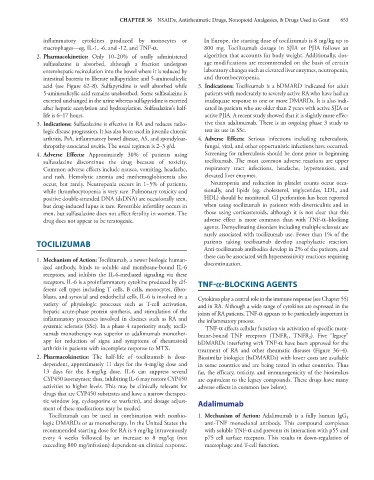Page 667 - Basic _ Clinical Pharmacology ( PDFDrive )
P. 667
CHAPTER 36 NSAIDs, Antirheumatic Drugs, Nonopioid Analgesics, & Drugs Used in Gout 653
inflammatory cytokines produced by monocytes or In Europe, the starting dose of tocilizumab is 8 mg/kg up to
macrophages—eg, IL-1, -6, and -12, and TNF-α. 800 mg. Tocilizumab dosage in SJIA or PJIA follows an
2. Pharmacokinetics: Only 10–20% of orally administered algorithm that accounts for body weight. Additionally, dos-
sulfasalazine is absorbed, although a fraction undergoes age modifications are recommended on the basis of certain
enterohepatic recirculation into the bowel where it is reduced by laboratory changes such as elevated liver enzymes, neutropenia,
intestinal bacteria to liberate sulfapyridine and 5-aminosalicylic and thrombocytopenia.
acid (see Figure 62–8). Sulfapyridine is well absorbed while 3. Indications: Tocilizumab is a bDMARD indicated for adult
5-aminosalicylic acid remains unabsorbed. Some sulfasalazine is patients with moderately to severely active RA who have had an
excreted unchanged in the urine whereas sulfapyridine is excreted inadequate response to one or more DMARDs. It is also indi-
after hepatic acetylation and hydroxylation. Sulfasalazine’s half- cated in patients who are older than 2 years with active SJIA or
life is 6–17 hours. active PJIA. A recent study showed that it is slightly more effec-
3. Indications: Sulfasalazine is effective in RA and reduces radio- tive than adalimumab. There is an ongoing phase 3 study to
logic disease progression. It has also been used in juvenile chronic test its use in SSc.
arthritis, PsA, inflammatory bowel disease, AS, and spondyloar- 4. Adverse Effects: Serious infections including tuberculosis,
thropathy-associated uveitis. The usual regimen is 2–3 g/d. fungal, viral, and other opportunistic infections have occurred.
4. Adverse Effects: Approximately 30% of patients using Screening for tuberculosis should be done prior to beginning
sulfasalazine discontinue the drug because of toxicity. tocilizumab. The most common adverse reactions are upper
Common adverse effects include nausea, vomiting, headache, respiratory tract infections, headache, hypertension, and
and rash. Hemolytic anemia and methemoglobinemia also elevated liver enzymes.
occur, but rarely. Neutropenia occurs in 1–5% of patients, Neutropenia and reduction in platelet counts occur occa-
while thrombocytopenia is very rare. Pulmonary toxicity and sionally, and lipids (eg, cholesterol, triglycerides, LDL, and
positive double-stranded DNA (dsDNA) are occasionally seen, HDL) should be monitored. GI perforation has been reported
but drug-induced lupus is rare. Reversible infertility occurs in when using tocilizumab in patients with diverticulitis and in
men, but sulfasalazine does not affect fertility in women. The those using corticosteroids, although it is not clear that this
drug does not appear to be teratogenic. adverse effect is more common than with TNF-α–blocking
agents. Demyelinating disorders including multiple sclerosis are
rarely associated with tocilizumab use. Fewer than 1% of the
TOCILIZUMAB patients taking tocilizumab develop anaphylactic reaction.
Anti-tocilizumab antibodies develop in 2% of the patients, and
these can be associated with hypersensitivity reactions requiring
1. Mechanism of Action: Tocilizumab, a newer biologic human- discontinuation.
ized antibody, binds to soluble and membrane-bound IL-6
receptors, and inhibits the IL-6-mediated signaling via these
receptors. IL-6 is a proinflammatory cytokine produced by dif- TNF-`-BLOCKING AGENTS
ferent cell types including T cells, B cells, monocytes, fibro-
blasts, and synovial and endothelial cells. IL-6 is involved in a Cytokines play a central role in the immune response (see Chapter 55)
variety of physiologic processes such as T-cell activation, and in RA. Although a wide range of cytokines are expressed in the
hepatic acute-phase protein synthesis, and stimulation of the joints of RA patients, TNF-α appears to be particularly important in
inflammatory processes involved in diseases such as RA and the inflammatory process.
systemic sclerosis (SSc). In a phase 4 superiority study, tocili- TNF-α affects cellular function via activation of specific mem-
zumab monotherapy was superior to adalimumab monother- brane-bound TNF receptors (TNFR , TNFR ). Five “legacy”
1
2
apy for reduction of signs and symptoms of rheumatoid bDMARDs interfering with TNF-α have been approved for the
arthritis in patients with incomplete response to MTX. treatment of RA and other rheumatic diseases (Figure 36–4).
2. Pharmacokinetics: The half-life of tocilizumab is dose- Biosimilar biologics (bsDMARDs) with lower costs are available
dependent, approximately 11 days for the 4-mg/kg dose and in some countries and are being tested in other countries. Thus
13 days for the 8-mg/kg dose. IL-6 can suppress several far, the efficacy, toxicity, and immunogenicity of the biosimilars
CYP450 isoenzymes; thus, inhibiting IL-6 may restore CYP450 are equivalent to the legacy compounds. These drugs have many
activities to higher levels. This may be clinically relevant for adverse effects in common (see below).
drugs that are CYP450 substrates and have a narrow therapeu-
tic window (eg, cyclosporine or warfarin), and dosage adjust- Adalimumab
ment of these medications may be needed.
Tocilizumab can be used in combination with nonbio- 1. Mechanism of Action: Adalimumab is a fully human IgG
1
logic DMARDs or as monotherapy. In the United States the anti-TNF monoclonal antibody. This compound complexes
recommended starting dose for RA is 4 mg/kg intravenously with soluble TNF-α and prevents its interaction with p55 and
every 4 weeks followed by an increase to 8 mg/kg (not p75 cell surface receptors. This results in down-regulation of
exceeding 800 mg/infusion) dependent on clinical response. macrophage and T-cell function.

